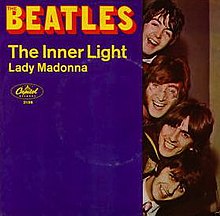The Inner Light (song)
| "The Inner Light" | ||||
|---|---|---|---|---|

US picture sleeve (reverse)
|
||||
| Single by the Beatles | ||||
| A-side | "Lady Madonna" | |||
| Released | 15 March 1968 | |||
| Format | 7-inch vinyl | |||
| Recorded | 13 January, 6 and 8 February 1968 | |||
| Studio | HMV Studios, Bombay; EMI Studios, London | |||
| Genre | Indian music, raga rock | |||
| Length | 2:36 | |||
| Label |
Parlophone (UK) Capitol (US) |
|||
| Writer(s) | George Harrison | |||
| Producer(s) | George Martin | |||
| the Beatles singles chronology | ||||
|
||||
"The Inner Light" is a song by the English rock group the Beatles, written by George Harrison. It was released on a non-album single in March 1968, as the B-side to "Lady Madonna". The song was the first Harrison composition to be featured on a Beatles single and reflects the band's embrace of Transcendental Meditation and his continued interest in Indian classical music. It is the last of three Indian-style tracks he wrote for the Beatles, after "Love You To" and "Within You Without You". The lyrics are a rendering of a poem from the Taoist Tao Te Ching, which Harrison set to music on the recommendation of Juan Mascaró, a Sanskrit scholar who had translated the passage in his 1958 book Lamps of Fire. The song became a comparative rarity among the Beatles' recordings in the decade following its release; it has subsequently appeared on compilation albums such as Rarities, Past Masters, Volume Two and Mono Masters.
Harrison recorded the instrumental track for "The Inner Light" in India in January 1968, during the sessions for his Wonderwall Music soundtrack album. The only Beatles studio recording to be made outside Europe, the song introduced instruments such as sarod, shehnai and pakhavaj to the band's sound and features contributions from Indian classical musicians including Aashish Khan, Hanuman Jadev and Hariprasad Chaurasia. Aside from Harrison's lead vocal, recorded in London, the Beatles' only contribution came in the form of group backing vocals at the end of the song.
...
Wikipedia
